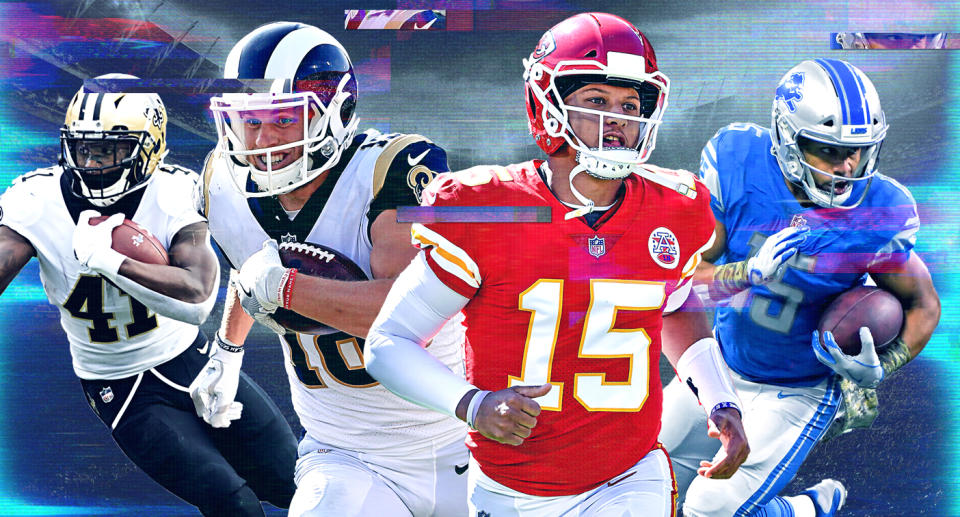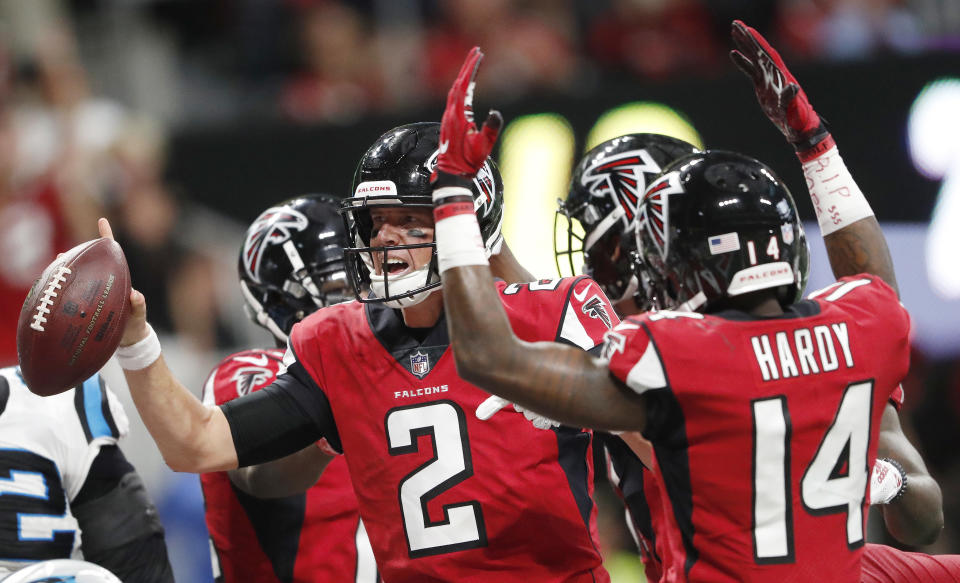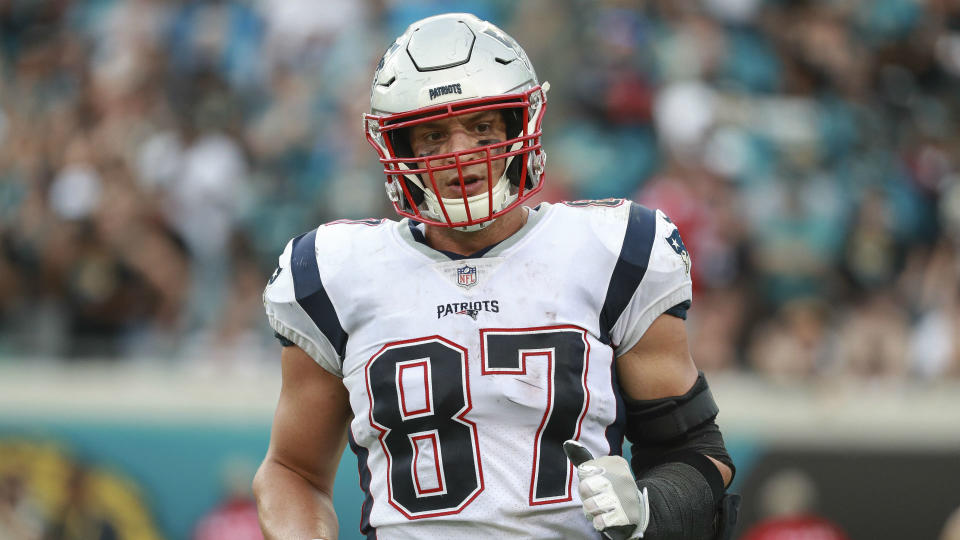How do Fantasy Football owners navigate NFL scoring binge in 2018?

We’ve had a month to digest the new NFL season. Everyone can feel the explosion and the aftershocks. Offense is going crazy. Points and yards are through the roof. Quarterback stats look like misprints. First team to 45 wins.
How did we get here? And what does a fantasy owner do with this new information? If fantasy drafts were reset right this second, how would we adjust?
If you like offense, 2018 is your NFL season. The league has a bunch of talented quarterbacks. An exciting new wave of coaches and offensive coordinators are running things. Defense is almost illegal — the quarterbacks are massively protectively, the downfield receivers and runners less threatened. The line separating college and pro football has never been more blurred.
Let’s get to the angles. Here are your takeaways and forward spins as we try to find winning plays for Fantasy Football 2018. (If you’re not in a long-read mood, there’s an outline of bullet points at the end.)
You Better Like the Coaching Staff
The NFL has always been a coaching league, but it feels more important than ever now. If you’re not innovating in today’s NFL, someone is passing you by.
Everyone knows how Sean McVay saved the Rams a year ago, and maybe it looks better because he replaced carbon-dated Jeff Fisher. The Bears were better the moment they sent John Fox packing, and in Week 4, finally, Matt Nagy started to look like a special hire. Andy Reid is one of the older coaches in the league, but he’s always been out ahead of trends and formational opportunities. Maybe Reid isn’t the guy you want calling timeouts or throwing a challenge flag, but he’s a dynamite coach in the film room and on the practice field.
Not every current headset inspires confidence, though. Can David Johnson succeed when OC Mike McCoy scarcely uses him in the passing game? Can the Seahawks, even with maestro Russell Wilson, overcome the dated principles of OC Brian Shottenheimer? Given that McCoy and Schottenheimer have been stubbornly tied to their principles for so long, I’m not confident. And heck, the best coaches apply a scheme that fits their talent; good coaches don’t try to force the same static game plan no matter who’s on the roster.
To be fair, the “good coach” tag is nebulous. Falcons OC Steve Sarkisian was a whipping boy for most of 2017, and Atlanta’s ugly opening-night loss to Philadelphia sharpened those narratives. The Falcons have been a red-zone machine since Week 1 — okay, Julio Jones isn’t invited to the party, but the offense overall is humming. Maybe Sarkisian was out of the Circle of Trust in early September, but we need to flip that now.
New Rules for Wide Receivers
In the high-stake Stopa League Auction back in July, I came away with two Rams wideouts. I’d never try for that up front and I didn’t in this case, but Robert Woods and Cooper Kupp were both affordable and I simply decided to gather talent and worry about balance later.
A month into the season, I’m starting to accept that Woods and Kupp don’t have to block each other out. Maybe I can keep starting both of them most weeks. (Full disclosure, this is a league that uses three wideouts and one common flex, in addition to a Superflex).
In previous NFL eras, it was rare to see a team have three wideouts carrying fantasy value. Today, the Rams have no problem getting goodies for Woods, Kupp, and Brandin Cooks. The Lions roll out three startable receivers in Golden Tate, Marvin Jones, and Kenny Golladay. It helps that the Rams and Lions rarely throw to their tight ends, but that’s also in part because they’re playing three-wide so much of the time (the Rams roll three wideouts an astounding 97 percent of the time; hat tip, Warren Sharp).
Tate and Tyreek Hill are two of the early “right answer” players, at least if you look at the League MVP tab on your Yahoo league. They were stars before this season, but the shape of 2018 seems to especially play to their specific talents. Tate is just 5-foot-10 and 197 pounds; Hill is 5-foot-10 and 185 pounds. There was a time when many smart pundits ran away from “smaller” receivers. But the NFL has essentially become a league of speed and agility more than one of power. Tate and Hill are playing in the best possible era for their skills.
It’s also time to stop viewing “slot receiver” as a pejorative. The middle of the field is often the richest part of the field, filled with coverage mismatches. Tyler Boyd looks like a league-tilting waiver add (it kills me to have zero shares). Kupp is having a field day. Quarterbacks know where the easy throws are.
There was a time where my flex spots would usually default to running backs, given their easier path to touches. That’s no longer a rule I subscribe to, and I actually find myself using wideouts in the flex spot more often than not. Season to taste.

Every Fantasy Owner (Probably) Has a Good Quarterback
Obviously any fantasy strategy can work if you pick the right players, and every position will have its share of “free loot” that’s drafted on the cheap or picked up for minimum waiver resources. But if there’s one position where you’re wise to try to get lucky, it’s quarterback.
The way most leagues are structured, it’s almost impossible to get “stuck” at quarterback. If you lost Jimmy Garoppolo, maybe you picked up Baker Mayfield. If you had Cam Newton on that Week 4 bye, maybe Marcus Mariota came through for you. Patrick Mahomes is the early MVP favorite and he was drafted as QB14 in Yahoo leagues. Matt Ryan was QB13, Jared Goff QB15. Andy Dalton tumbled all the way to QB26.
Another record-breaking week:
Passers threw for 9,074 yards in week 4, across 30 teams. That’s an average of 302.5 passing yards per game, the most in a single week in NFL history.
Teams averaged 284.9 passing yards/game (i.e., net of sacks), which is also a record).
— Football Perspective (@fbgchase) October 2, 2018
Say whatever you want about Jameis Winston, but he’s starting again, the Bucs have weapons, and that defense stinks. He could be a mid-season difference maker starting Week 6 against Atlanta.
I get asked every week, what can I get for (this quarterback in trade)? What can I get for Andrew Luck, or Phillip Rivers, or Ben Roethlisberger? The tricky thing is, you might not have a trading market. You need to find someone desperate at quarterback before you can negotiate a trade involving one. The league has never been this strong at its most important position.
Bye Weeks Can Be Your Best Friend
Ah, so that’s how you trade from a quarterback surplus (maybe). A fantasy season doesn’t really start until the byes kick in and a few teams start getting separation. Your league probably has that now. Although many teams are in the undefined middle, strong teams and weak teams have probably left fingerprints.
The weakest fantasy owners tend to hate bye weeks, because they want simplicity; get my best players on the field, dammit. The shrewder player likes bye weeks for the opportunities that arise. Here’s where you can start trading today for tomorrow or tomorrow or today, depending on what your situation is.
Appreciate that bye weeks are not created equal. Four of the bye weeks — Weeks 4, 5, 6, and 12 — only have two teams resting. If you have key players on a “skinny” bye week, you’ll probably enjoy the flexibility later. The Chiefs and Rams share the Week 12 bye (and no one else rests that week) — another reason why those teams are a 2018 cheat code. (Then again, the league could be upside down in two months. That’s why I favor a microscope over a telescope for most fantasy analysis.)
The two thickest bye weeks are Week 9 and Week 11 with six teams resting each week. Those will be two of the busiest trading and pickup weeks of the season.
Go Where the Points Are
It’s the simplest concept in the world: we want players on teams with good offenses. We avoid players on a bad offense. And if our players are on Carnival teams — teams with a loaded offense and a putrid defense — then we’ve really hit the jackpot.
Kansas City, Pittsburgh, Atlanta, Houston, and New Orleans all have strong Carnival potential — fireworks on offense, a dumpster fire on defense. Tampa Bay’s defense is there, it’s just a matter of Winston clicking in the offense (I’d bet he will). Minnesota’s defense hasn’t been what we expected. The Bengals, Chargers, and Lions have given up a bundle of passing yards, offset by their offensive potential (please get Kerryon Johnson the rock, Detroit).
As for nasty defensive matchups, those are almost extinct. The Jaguars and Bears present problems. Baltimore’s defense is off to a strong start. The Browns might have a plus defense. But it’s mostly a green-light league in 2018.
Usage Trees, Thin and Narrow
When McVay dials up plays for the Rams, he has four skill players in mind: Todd Gurley and his three wideouts. He’s not obsessed with being cute or steering a bunch of touchdowns to his lesser players. This is a highly-concentrated offense, a unit that focuses on its best players. This is precisely what fantasy owners want.
Contrast this to a team like Miami, where no one has more than 19 targets and Frank Gore continues to split work with Kenyan Drake. Somehow Ryan Tannehill has an 8.4 YPA and 106.1 rating, but there’s no one we can trust in this offense. It breaks my heart to keep benching Kenny Stills, but I can’t assume rational coaching in Miami. I have to accept the hand they’re dealing us.
Tight End Attrition Rules The World
This position always features a high injury rate, but it’s been out of control this year. We lost Hunter Henry even before draft season started. Delanie Walker and Tyler Eifert are out for the year. Greg Olsen, O.J. Howard, Jack Doyle, and Evan Engram are going to miss multiple games. That’s about half of the Top 15 at the position. We don’t know where the Rob Gronkowski story is headed, either.

I’ve treated tight end depth as more of a priority this year; while you can usually pick up something useful after the fact, you pay a lot less if you do it ahead of time. Pretty much all of my MFL rosters have at least three tight ends. I bought three in the Stopa League, where we start two and have limited benches. I want to hunt for affordable, plausible upside where I can find it.
Running Back — Go Big or Get Lucky (Or Both)
For the most part, running backs have been the most important players in the fantasy era. But when the league saw a healthy passing spike earlier this decade — coinciding with a host of running-back injuries — the Zero-RB theme started to gain traction. Zero RB was best utilized, of course, when it wasn’t spoken of so much. It was more of an ambush strategy then. Once it became a common angle, a lot of the value leaked out.
Wide receivers grabbed a healthy chunk of the 2017 draft season only for the running backs decided league titles. Gurley was one of the biggest league-deciders, but he was far from alone.
Entering 2018, running backs took over the first round again. But no matter who was drafting running backs early, most owners could agree on one thing: you want a bunch of your bench slots earmarked for high-upside and speculative RB plays.
If I were doing a redraft this minute, I’d focus on a strategy I call Anchors Aweigh — the idea that you get one big, bad, touch-dominating back, then hammer the other positions. There aren’t that many backs who justify a first-round ticket, but if you can land a true bell cow, you’ve solved so much of the puzzle. I realize this is second nature to most experienced players.
But if you were redrafting and had slot that didn’t allow for a heavy-touch back, I wouldn’t force it. In one industry league this summer, I had the 12 pick and hated the backs left to me at the time. I said screw it, give me Julio and Hopkins, and decided I’d go running back on a budget.
Even with a Rex Burkhead pick that bricked out quickly, I like the shape of that roster (I know, no one cares about someone else’s fantasy roster; I’ll fine myself $5). I need to find answers in the backfield, like most teams, but I’m strong everywhere else and off to a fast start. Here’s the core of the team (I’m glad we can start three or four wideouts because I have some toys):
QB: Stafford, Dalton
RB: Lynch, Collins, Morris, Smallwood, Murray, Gallman
WR: Jones, Hopkins, Thielen, Kupp, Lockett, Agholor
TE: Kittle, Graham
(I did try to trade Thielen for Jordan Howard last week. I’m glad that owner never replied.)
For more thoughts about Zero RB, Big-Ticket RB, and the One-Back theories, I strongly encourage you to check out the Twitter thread Sammy Reid posted about five weeks ago. Along with Shawn Siegele’s archived stuff (he was the founder of Zero RB), it’s the best thing I’ve read on the topic.
Too Long, Didn’t Read
• With new rules and offensive shapes, defense is all but impossible. Scoring is here to stay.
• Offensive coaching has never been more important in the NFL and for our fantasy purposes.
• Undersized receivers can still dominate; it’s become a game about speed, agility, and mismatches.
• Running backs are no longer the default choice at the flex position.
• It’s very hard for a fantasy owner to get stuck at quarterback, and it’s an easy position to navigate on the cheap.
• Use standings-leverage and bye weeks to incentivize trade talks.
• Target players on Carnival teams (strong offense, poor defense) and teams that have concentrated usage patterns.
• Tight end depth is sneaky-important given the injury rates at that position.
• Everyone wants a bell-cow RB (but they are extremely rare), and then it’s all about hoarding lottery tickets.
As always, your mileage may vary, it’s always contextual, and you know your league better than anyone else does.
Follow Scott Pianowski on Twitter.

